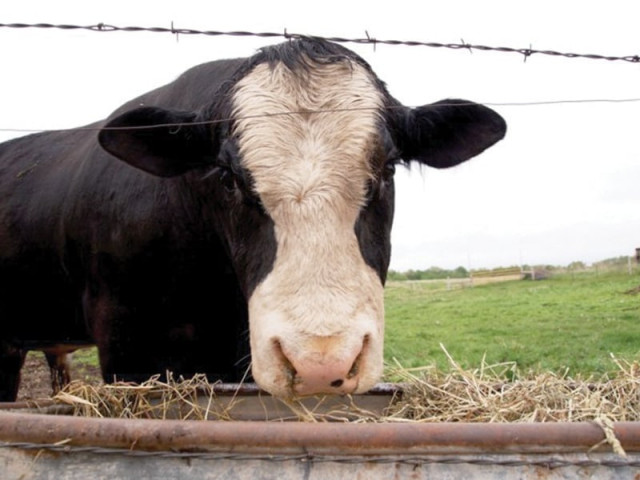Livestock insurance: Farmers not educated enough to derive benefits
Progress can be made only if farmers understand advantages of the scheme.

The State Bank of Pakistan, in association with the SECP, has developed a framework for livestock insurance for borrowers. PHOTO: FILE
According to a Food and Agriculture Organisation (1997) report, the best buffaloes are available in Pakistan, which have been termed ‘Black Gold of Asia’ and average yield per lactation has been recorded at 1,800 to 2,500 litres while few species can produce up to 6,000 litres in 305 days.
There are about 25 and 27 million cattle and buffaloes respectively in the country. The Landhi Cattle Colony is the world’s biggest concentration of buffaloes/cattle at one place. This colony, which is usually referred to as Bhains Colony, has a dairy animal population of about 400,000 with a daily yield of about four million litres of milk.
Dairy and livestock production consists of 55% of the country’s total agriculture production and contributes 11.04% to the GDP. But unfortunately this sector has been ignored by banks and lending agencies and the major reason for the low credit offers is inadequate availability of appropriate insurance cover.
Naturally, no bank will lend money to a person or an organisation without covering the risk factor because inadequate risk management can result in severe consequences for companies as well as individuals. Bank financing for the livestock, dairy and meat sector was only Rs56 billion, constituting just 17% of the total agriculture lending in the current fiscal year.
To solve this problem, the State Bank of Pakistan, in collaboration with the SECP, banks, insurance companies and provincial livestock and dairy departments, has developed a framework for livestock insurance for borrowers. The idea is to improve provision of finance to the livestock and dairy sector by minimising the risk of loss.
The scheme would safeguard the interest of farmers in case of death of their animals – buffaloes, cows and bulls – due to disease, accident, flood, heavy rains and storm. Under the scheme, banks will obtain insurance of all livestock loans up to Rs5 million for the purchase of animals. The SBP has advised banks to implement the scheme and enter into agreements with reputable insurance companies for underwriting livestock insurance for their borrowers.
The central bank will also request the government to bear the cost of insurance premium for small farmers through budgetary support as is being done under its mandatory Crop Loan Insurance Scheme for five major crops.
This is undoubtedly a very good decision and will definitely help modernise cattle farming in the country. But are the cattle farmers educated enough to derive benefits from this scheme? No. Most of those involved in the business of cattle farming are not qualified enough to understand the importance of developing a fully-equipped modern cattle farm.
There is a need to publicise the scheme, educate them and persuade them to develop farms on modern lines. Mere introduction of the plan will not result in any progress unless the farmers understand the benefits of the scheme.
Schemes developed with lot of research, series of consultations and visionary planning cannot be translated into reality unless they are based on facts like target area, behavioural pattern of the ultimate beneficiary and prevalent socio-political scene of the region.
It is, therefore, necessary that a comprehensive plan for effective implementation of the scheme be prepared and a team of banking counsellors be set up to educate the cattle farmers and disburse loan to them.
It is very unfortunate that despite the important role of livestock in Sindh’s economy, it has not yet received required attention from the planners. There is a need to motivate the thinking of professional economists and owners of livestock in rural areas of Sindh with a view to finding ways and means to increase the per lactation yield.
Although per animal milk yield is lower than other countries, Pakistan is the third largest milk producing country in the world. Increase in milk production is due to increase in quantity of livestock population. It is, therefore, important to introduce improved technological methods in dairy farming to enhance per animal milk production and meet international market standards.
Huge losses are faced by the farmers due to improper transportation, unavailability of interconnected cold storage chains, etc.
The writer is a freelance contributor and a PR consultant
Published in The Express Tribune, December 2nd, 2013.
Like Business on Facebook, follow @TribuneBiz on Twitter to stay informed and join in the conversation.



















COMMENTS
Comments are moderated and generally will be posted if they are on-topic and not abusive.
For more information, please see our Comments FAQ